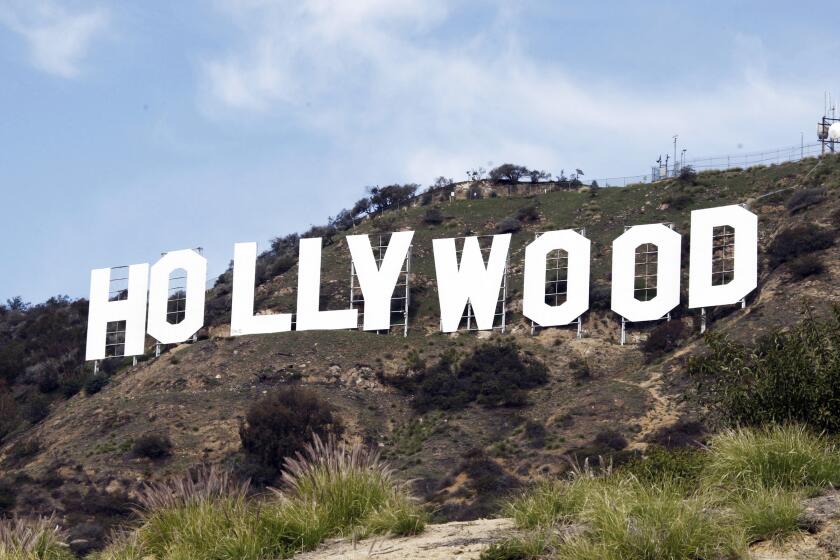SAN DIEGO GALLERIES / David Lewinson : Works Draw Upon Wrong Definition
- Share via
The visual arts merit special notoriety for the vast number of words in their vocabulary that have no agreed-upon meaning beyond an often uselessly general one. Art itself is such a word, and so is drawing .
At the Dietrich Jenny Gallery (660 9th Ave.), the current show is titled “Drawings by Artists We Like.” According to my definition of drawing , however, there aren’t many of these among the 16 works by 13 artists.
I think of drawings not in terms of media used, but as more informal and personal efforts than an artist’s finished pieces. They’re often quick attempts to capture a fleeting idea, or they can be experimental in nature, a working out of problems in representation or composition arising elsewhere in the artist’s work. Drawings can also be exercises that strengthen skills or playful muckings-around that can expose new possibilities. At least, these are some of the characteristics that make drawings special.
Few works in this show measure up to those criteria. Amanda Farber’s “One, Two” simply states a relationship of two shapes on a large piece of paper. There’s no suggestion of how these forms got to be in that relationship--a perfect task for drawing--so what we see is a done deed.
Similarly, the trio of skull images by David Wilson looks like all the work is over, although adjustments of some sort must have been part of the artist’s process in creating these works. Mathieu Gregoire’s images are project documents that reveal no intimacy or personality at all.
Drawing doesn’t preclude the use of color, of course, and color is found aplenty in Patricia Patterson’s and Steven Criqui’s works; but these look so much like the artists’ finished paintings that the distinction between these and drawing becomes virtually meaningless. Nevertheless, it is in works with color that some hint of what’s special about drawing emerges from this show.
Ernest Silva’s watercolor “House of Twigs” looks very much like the beginning of an idea for a painting. It reveals something of the structure by which the paintings are built, but has none of the monumentality of the finished work. “Untitled From Stationery Series” by Manny Farber (daughter of Amanda) is also a watercolor, and it seems to fulfill the same type of function as Silva’s. It’s basically a study that’s more developed than a pencil sketch might be, but far less ripe than what one thinks of as a full-on Farber painting.
In these two works, we sense the artists working at something--testing, exploring and having fun doing it. Their results are images that make sense to exhibit on their own, even though they’re “only” drawings.
The show continues through April 15.
An eerie presence fills the small Sonic Arts Gallery downtown, the result of Alaskan artist David Felker’s suggestively titled exhibition, “Sonance from the Vessel: An Alchemic Voyage” (through April 1).
Felker’s installation consists of a 16-foot-long canoe-like structure formed of gray PVC pipe and brittle, translucent plastic stained a hide brown. By use of wires stretched to the gallery walls, this frail form hovers in space, looking gossamer and strangely weightless. On the floor beneath the vessel lies a cluster of antiquated machine parts, a large multicell battery and a glass tube for measure the movement of air. Heavy wires lead from this assemblage to the vessel above and to sockets in the gallery walls.
Above the vessel is a large, square, dark green tarpaulin painted with two white concentric rings, like a target; while between this tarp and the suspended boat, a taut, bright metal cable runs the length of the gallery. From behind a partition, a device of some sort occasionally plucks the cable, producing a tone (perhaps the sonance of the show’s title) that blends the sound of a drone, a cymbal and a gong.
The summary effect of all of this is highly suggestive of that kind of spirit voyage conjured up by thoughts of ancient Egypt’s Pharaohs, whose tombs were equipped with all sorts of gear, and of the American Indians, who envisioned that upon death, the spirit quite literally voyaged through a universe unknown to souls still living in the flesh.
This sense of the ancient and the other is compelled by the combination of forms, materials and sound that Felker has produced here. Each element is familiar--a canoe, a battery, a motor, a tarp, a plucked cable--yet each is somehow “other” in either a cultural or historical sense. The machine elements, for example, look so old as to seem virtually medieval, as though more from the era and mind set of Frankenstein than of current high-tech times.
The result is a kind of techno-primitivism that breaks through the glossier layers of contemporary culture to expose the issues of body, mind and spirit that are the primal concerns of all cultures in all times and all places. The alchemists of premodern Western culture, who are evoked in the exhibition title, viewed these concerns as central to their activity and sought to understand their unity and interaction, much as modern culture would still like to do.
That Felker has also placed in the gallery a bottle of sulfur, an assemblage of bags of salt and a jar of some unknown fluid encrusted with mold only emphasizes what he perceives as his links to what is obviously not an entirely dead alchemic tradition. His task here is not to turn lead into gold but to turn disparate materials into provocative art that transmutes mundane experience into something much more profound and vital.
Sonic Arts Gallery is at 612 F St. Hours are noon to 5 p.m. Thursday through Saturday.
More to Read
The biggest entertainment stories
Get our big stories about Hollywood, film, television, music, arts, culture and more right in your inbox as soon as they publish.
You may occasionally receive promotional content from the Los Angeles Times.










